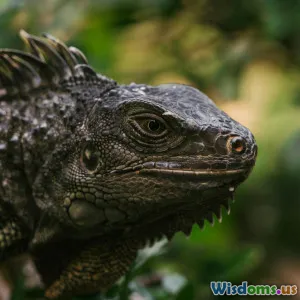
Evolutionary Biology: Key Concepts
8 min read Explore the key concepts of evolutionary biology and their significance in the animal kingdom. (0 Reviews)
Evolutionary Biology: Key Concepts
Introduction
In the intricate tapestry of life on Earth, every organism is a distinct thread that weaves together to form the rich biodiversity we see today. But how did this complex system of life emerge? The answer lies largely within the realm of evolutionary biology, a field that attempts to unveil the processes and mechanisms that drive changes in species over time. By exploring evolutionary biology, we gain insights into not only why organisms look and behave the way they do but also how they adapt to their environments and how they relate to one another within the animal kingdom. In this article, we will break down essential concepts of evolutionary biology and illuminate their real-world implications.
The Foundations of Evolutionary Biology
Evolutionary biology integrates multiple scientific disciplines such as genetics, paleontology, and ecology to elucidate the origin and diversification of life forms. At its core, it revolves around several key principles:
Natural Selection
One of the cornerstones of evolutionary biology is natural selection, a process famously articulated by Charles Darwin. Natural selection occurs when individuals with advantageous traits are more likely to survive, reproduce, and thus pass on those beneficial traits.
- Example: The classic example of this phenomenon can be seen in the peppered moths in England, which transitioned from light to dark-colored forms during the Industrial Revolution. As soot blackened the trees, darker moths were better camouflaged from predators, leading to their increased survival and reproduction.
Mutation
Mutations are random changes in an organism's genetic material. While many mutations are neutral or deleterious, occasionally, beneficial mutations can occur, leading to new traits that enhance an organism's adaptability.
- Example: The emergence of antibiotic-resistant bacteria is a direct result of mutations allowing these organisms to survive in environments laden with antibiotics, a prime concern in modern medicine.
Genetic Drift
Genetic drift refers to random changes in allele frequencies within a population, especially in smaller populations where chance plays a significant role. This mechanism can lead to significant evolutionary changes over time, regardless of natural selection.
- Example: The founder effect is a practical instance of genetic drift whereby a new population established by a small group of individuals may exhibit markedly different genotype frequencies compared to the original population.
Speciation
Speciation is the evolutionary process by which populations evolve to become distinct species. This occurs through various mechanisms, including allopatric speciation, where populations are geographically separated, and sympatric speciation, where new species arise without physical barriers.
- Example: The Galápagos finches observed by Darwin are a textbook example of allopatric speciation—each island's unique environments fostered the development of different finch species specialized for their respective niches.
The Evidence Supporting Evolution
To validate his theory, Darwin relied on a formidable body of supporting evidence, which modern evolutionary biology has expanded significantly. Here are some key types of evidence:
Fossil Records
Fossils provide crucial evidence of the timelines and morphological changes of various species. Transitional fossils, such as Archaeopteryx, illustrate the intermediate forms between reptiles and birds.
Comparative Anatomy
The study of anatomical structures across different species reveals evolutionary connections. Homologous structures, such as the forelimbs of both whales and humans, exhibit a common ancestry, albeit adapted for different functions.
Molecular Biology
The molecular data deployed in evolutionary studies provide insights into genetic relationships. Comparative genomics allows scientists to analyze similarities and differences in DNA sequences, contributing to our understanding of evolutionary lineages.
Biogeography
The geographic distribution of species often aligns with evolutionary history. For example, marsupials are primarily found in Australia, a testament to historical land formations and how they shaped evolutionary paths.
Evolutionary Developmental Biology (Evo-Devo)
A relatively newer discipline, evolutionary developmental biology (evo-devo), explores the relationship between embryonic development and evolutionary changes. It poses vital questions about how developmental processes influence the evolution of organisms.
The Role of Hox Genes
Hox genes are pivotal in determining the body plan of many animals. Variations in these genes can lead to profound structural differences in body layouts, facilitating the evolution of diverse life forms while highlighting the shared ancestry across species.
- Example: The restructuring of Hox genes was instrumental in the development of different body forms in arthropods and vertebrates, showcasing how relatively minor genetic changes can yield extensive morphological adaptations.
The Role of Evolution in Modern Biology
Understanding evolutionary mechanisms is crucial in fields such as medicine, conservation biology, and agriculture.
Modern Medicine
Evolutionary principles are vital in developing effective treatments. For instance, studying how pathogens evolve their resistance enhances our strategies against infections.
Conservation Biology
Evolutionary biology also plays a significant role in conservation efforts, guiding strategies for maintaining genetic diversity and resilience in threatened populations—the loss of genetic variation increases a species' vulnerability to extinction.
Agriculture and Animal Husbandry
In agriculture, artificial selection has been used to breed plants and animals with desirable traits, guiding the practices based on an understanding of genetic variation drawn from evolutionary theories.
Conclusion
In summary, evolutionary biology is a profound field that illuminates the intricate connections and processes underlying the diversity of life on Earth. By understanding the fundamental concepts of natural selection, mutation, genetic drift, and speciation, alongside the robust evidence supporting these mechanisms, we appreciate the complexities of the animal kingdom. Beyond academic inquiry, grasping these concepts proves pivotal across various domains, affirming the vitality of evolution in modern science and daily life. Ultimately, the study of evolutionary biology enriches our understanding of who we are and underscores the interconnectedness of all life forms.
The story of life is not merely one of survival but a historical tapestry defined by change, adaptability, and resilience. As curiosity drips from our pursuit of understanding, the lessons learned from evolutionary biology continue to inspire new generations to explore the wonderful intricacies of the natural world.
Rate the Post
User Reviews
Popular Posts





















